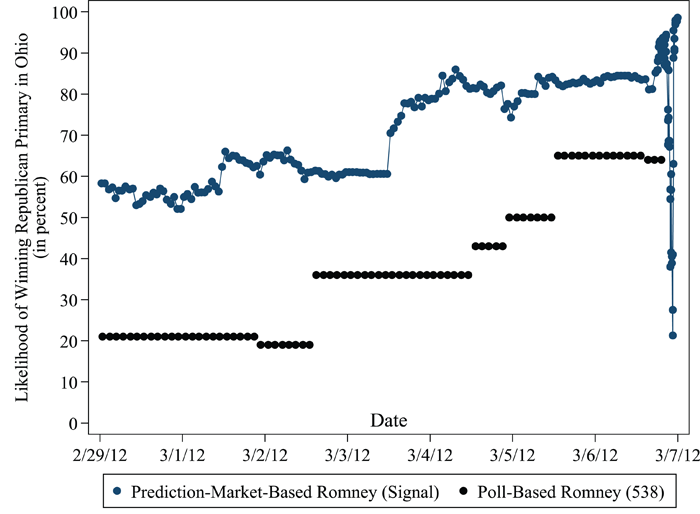As go the prediction markets, so goes Ohio
Ten states voted in caucuses and primaries on Super Tuesday, but you could be forgiven for thinking only Ohioans were holding a primary contest, given the news industry's relentless obsession with the state. Now that the dust has settled, let's have a look at how poll-based and market-based prediction engines fared in foreseeing the victor.
Polls are a key ingredient in making political forecasts. They specialize in providing a snapshot of the current state of the election, and will be a critical part of the Signal's general election predictions beginning in September, when the Republican's finally have a nominee and the picture in November has clarified. But they are only one piece of the puzzle. A survey cannot completely account for variables like a candidate's cash on hand, organization and general momentum in the political narrative. A wealthy, organized candidate with a strong presence in a state can boost his numbers in the polls and ballot box by utilizing that advantage, reaching more voters than his opponent, but polls are fundamentally backward-looking. They tell us how organized the candidates were last week but not their position going forward.
The reason we're obsessed with the prediction markets, in which real people place real money on their expectation of the outcome, is that the participants are rational actors who can account for every variable. We saw this fact play out very clearly in the week between the Feb. 29 primaries in Michigan and Arizona and the 10-state election on March 6.
After Mitt Romney's victories over Rick Santorum in Arizona and Michigan, the polls continued to lag a few days behind Romney's momentum and cash advantage. Prediction markets were able to incorporate that information in real time. The following chart shows the movement in the likelihood of victory in Ohio for our market-based forecast and the more standard poll-based forecast from the New York Time's FiveThirtyEight blog.
The final few hours reflect a different set of information: Exit polls and results. There are no further polls conducted after the exit polls. The media releases the exit polls as the voting booths close; in Ohio they showed a tight election, but favored Romney by a slim margin.
As you can clearly see, the markets panicked when, after 2 hours and 20 minutes, the returns favored Santorum by 15,000 votes; Romney and Santorum then continued to trade the lead for about 30 minutes until Romney pulled ahead for good. Was it efficient for the markets to move so much? Maybe; the markets were doing a yeomen job in aggregating a lot of tricky information at that point in the evening, so there is a lot more uncertainty than the lead-up to Election Day. Romney moved back up above Santorum, still down by 12,000 votes with over 50% of the state reported. Collectively the market was providing a careful analysis of returns, which were suggesting that counties posting earlier results disproportionately favored Santorum, indicating that Romney would have the better end game as the night wore on. Cuyahoga County, as an example, reported just a few percent for several hours. But the county, home to Cleveland, showed a heavy Romney lead and promised to deliver him many more votes as more returns came in.
A win for Santorum was never out of the question in Ohio. The markets afforded him a very real chance of victory of around 20 percent going into the night. But they were able to call the state for Romney well ahead of any network's official determination. And of course, those driving the markets watched the polls as closely as the professionals. Still, the vast majority of prognosticators continue to exercise an abundance of caution while relying on backward-looking surveys for the majority of their information. That strikes us as primitive.
David Rothschild is an economist at Yahoo! Research. He has a Ph.D. in applied economics from the Wharton School of Business at the University of Pennsylvania. Follow him on Twitter @DavMicRot and email him at thesignal@yahoo-inc.com.
Want more? Visit The Signal blog, connect with us on Facebook, and follow us on Twitter. Handy with a camera? Join the Yahoo! News Election 2012 Flickr group to submit your photos of the campaign in action.



